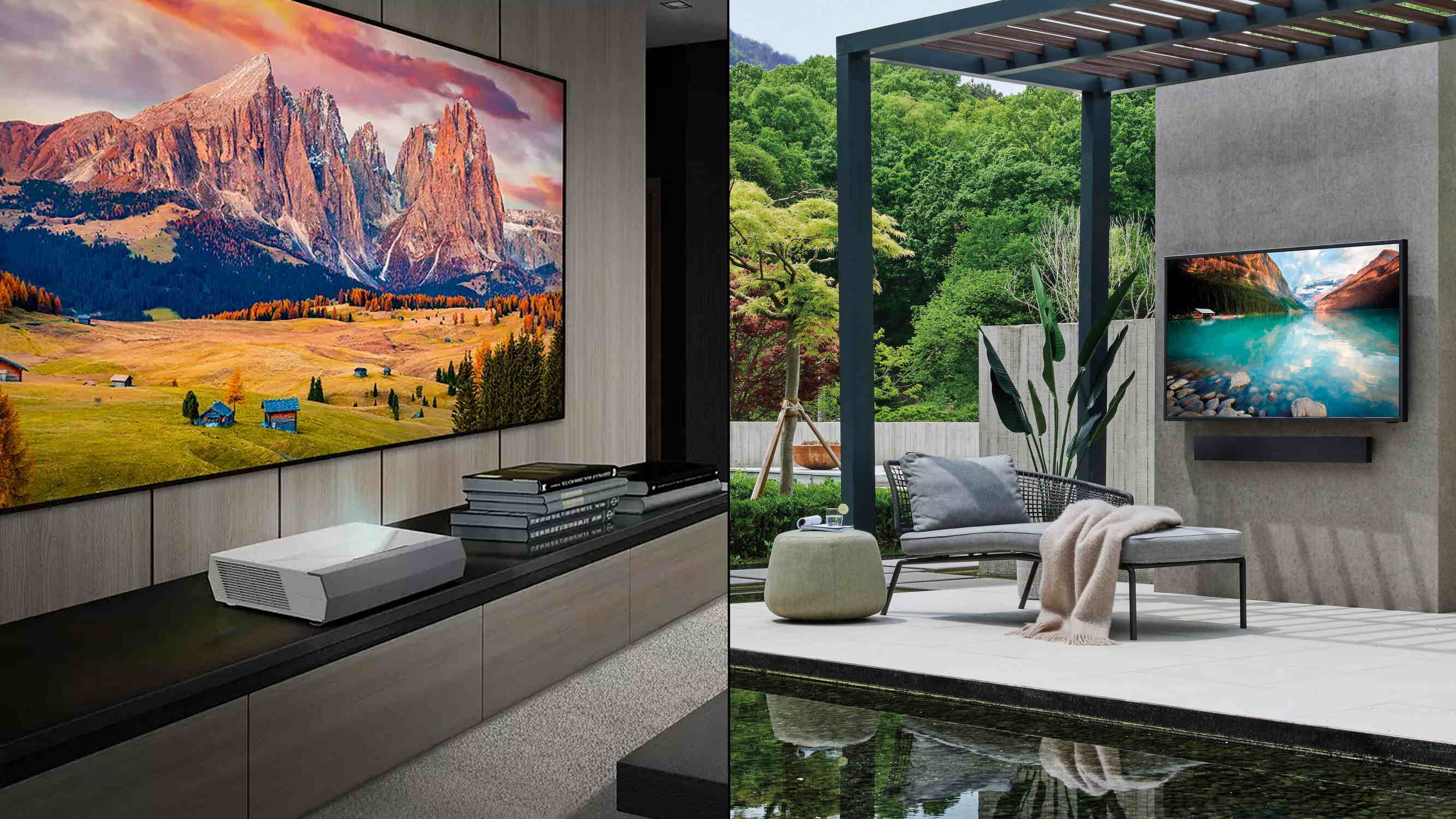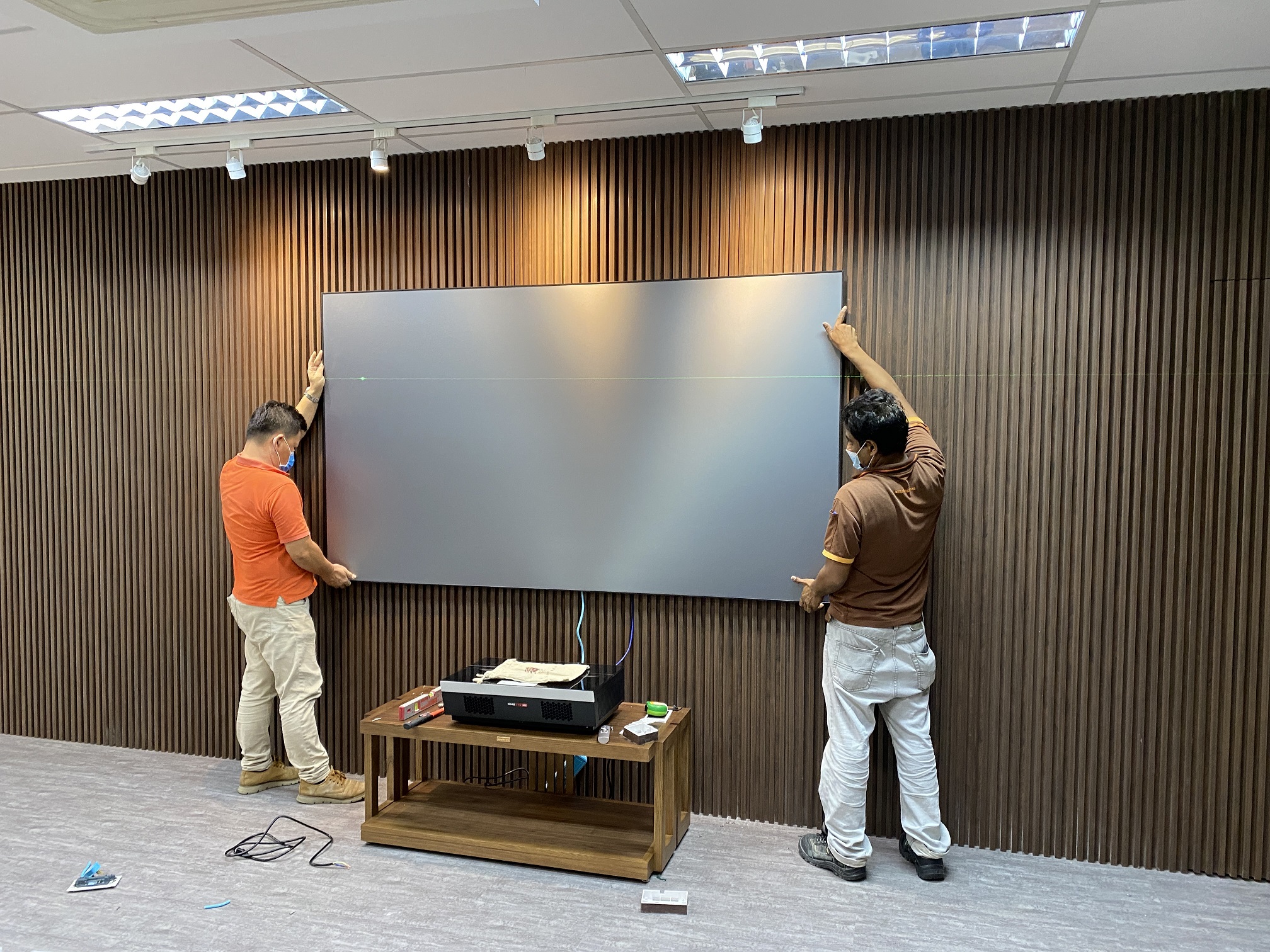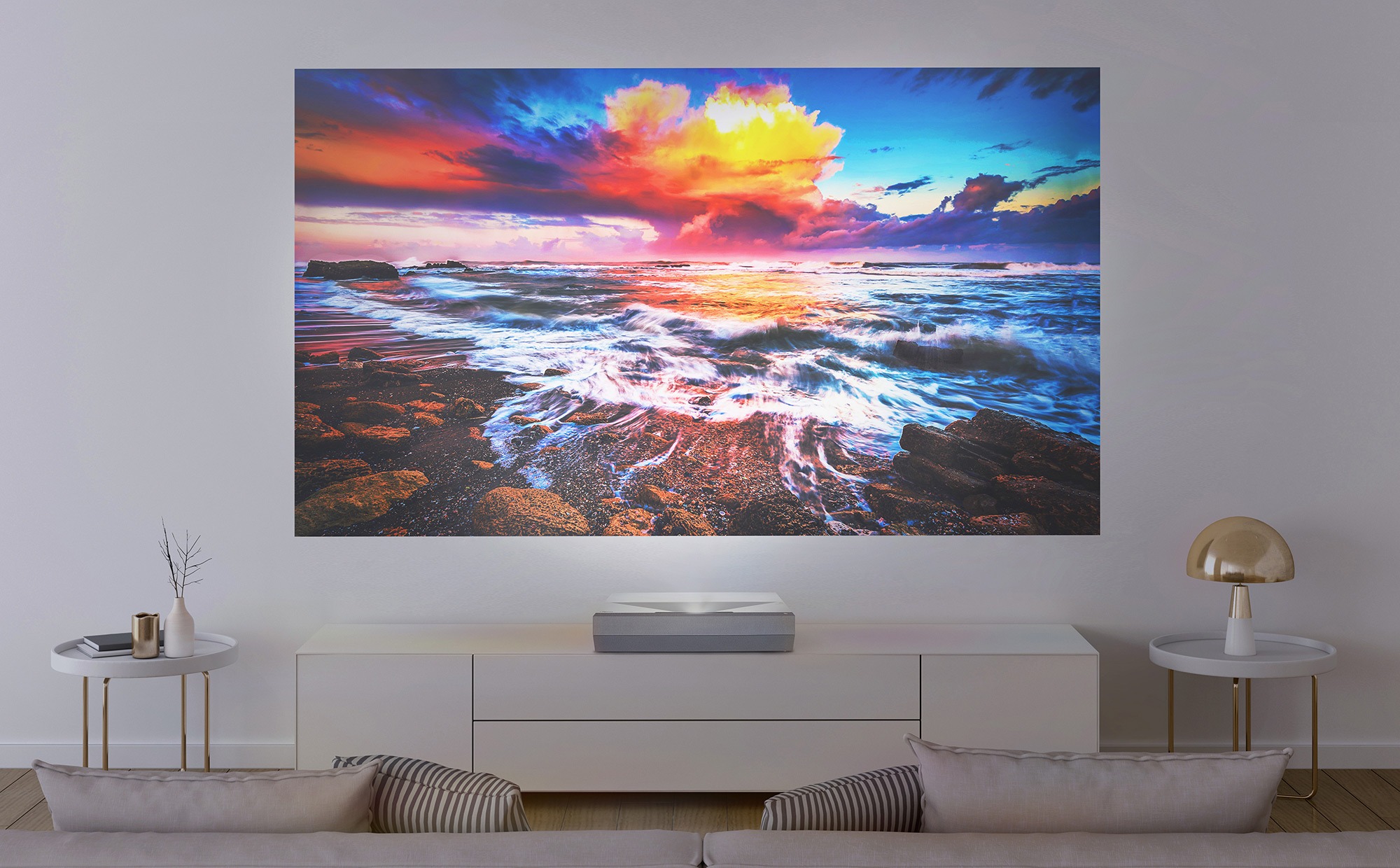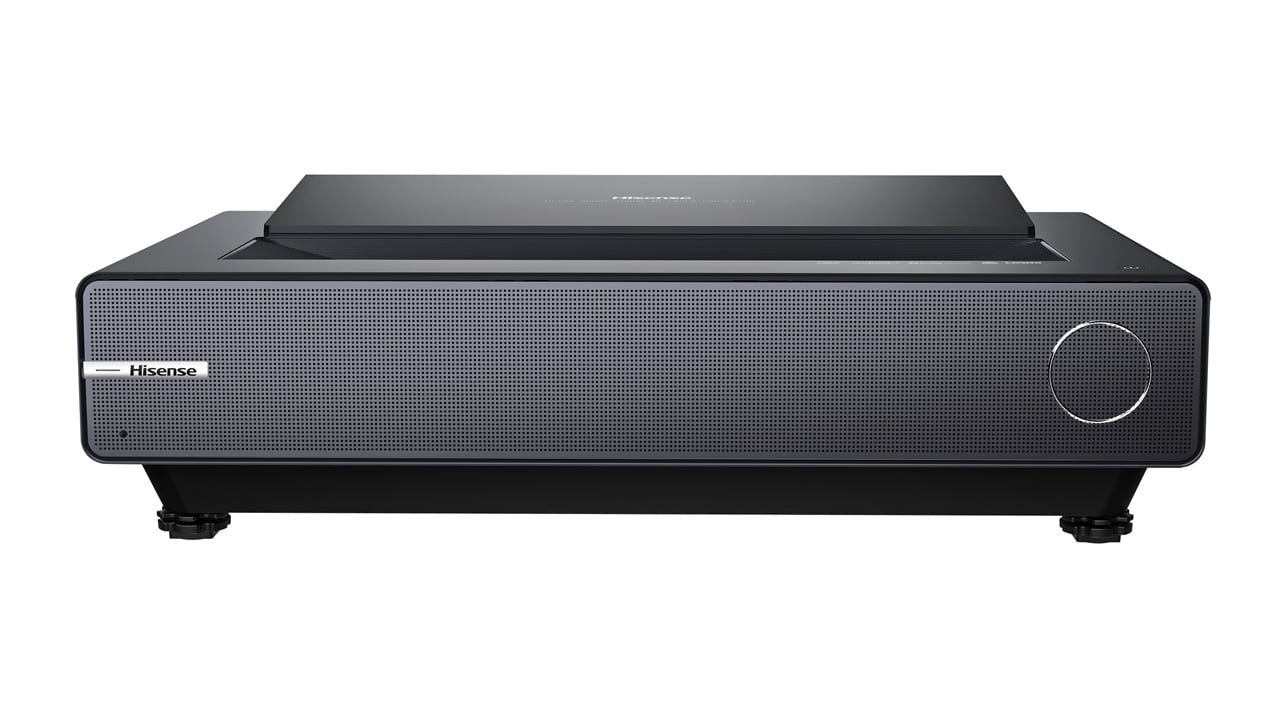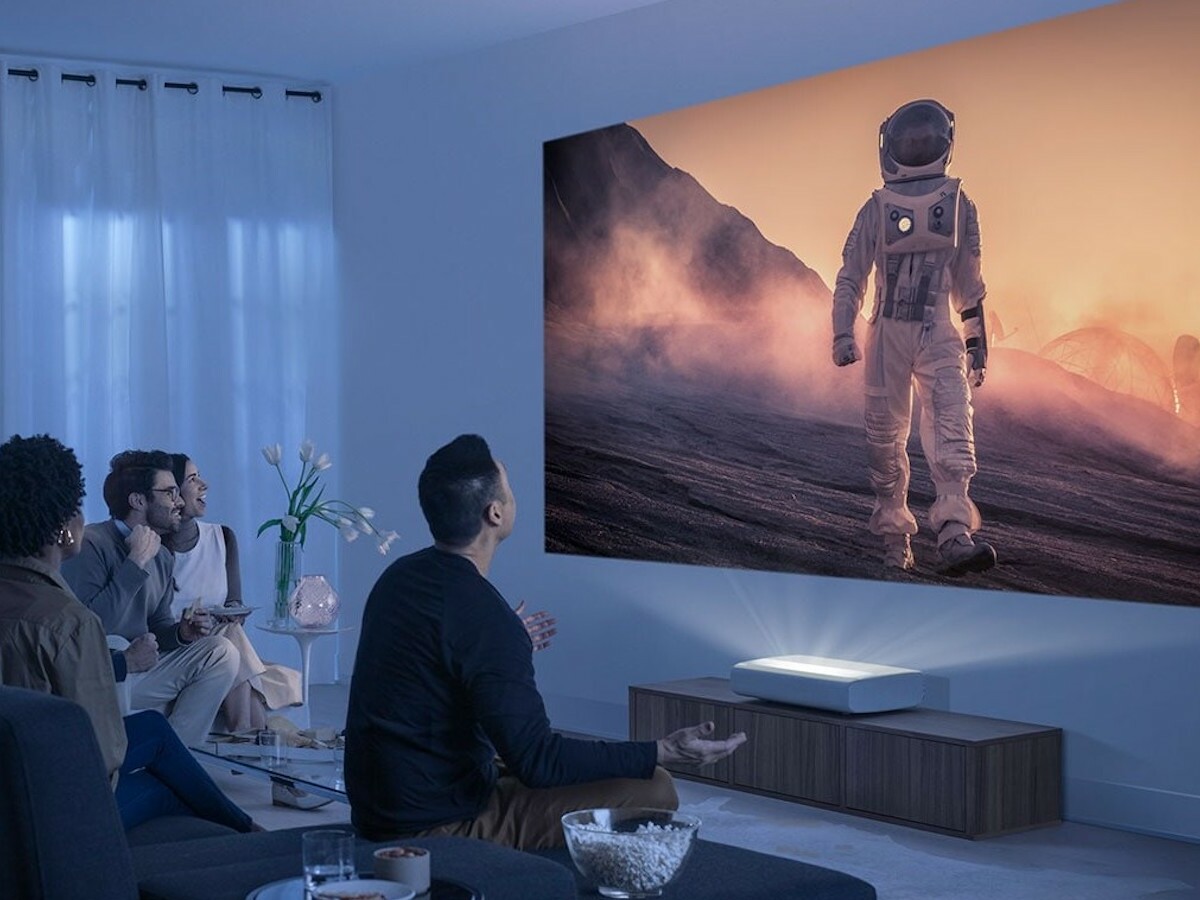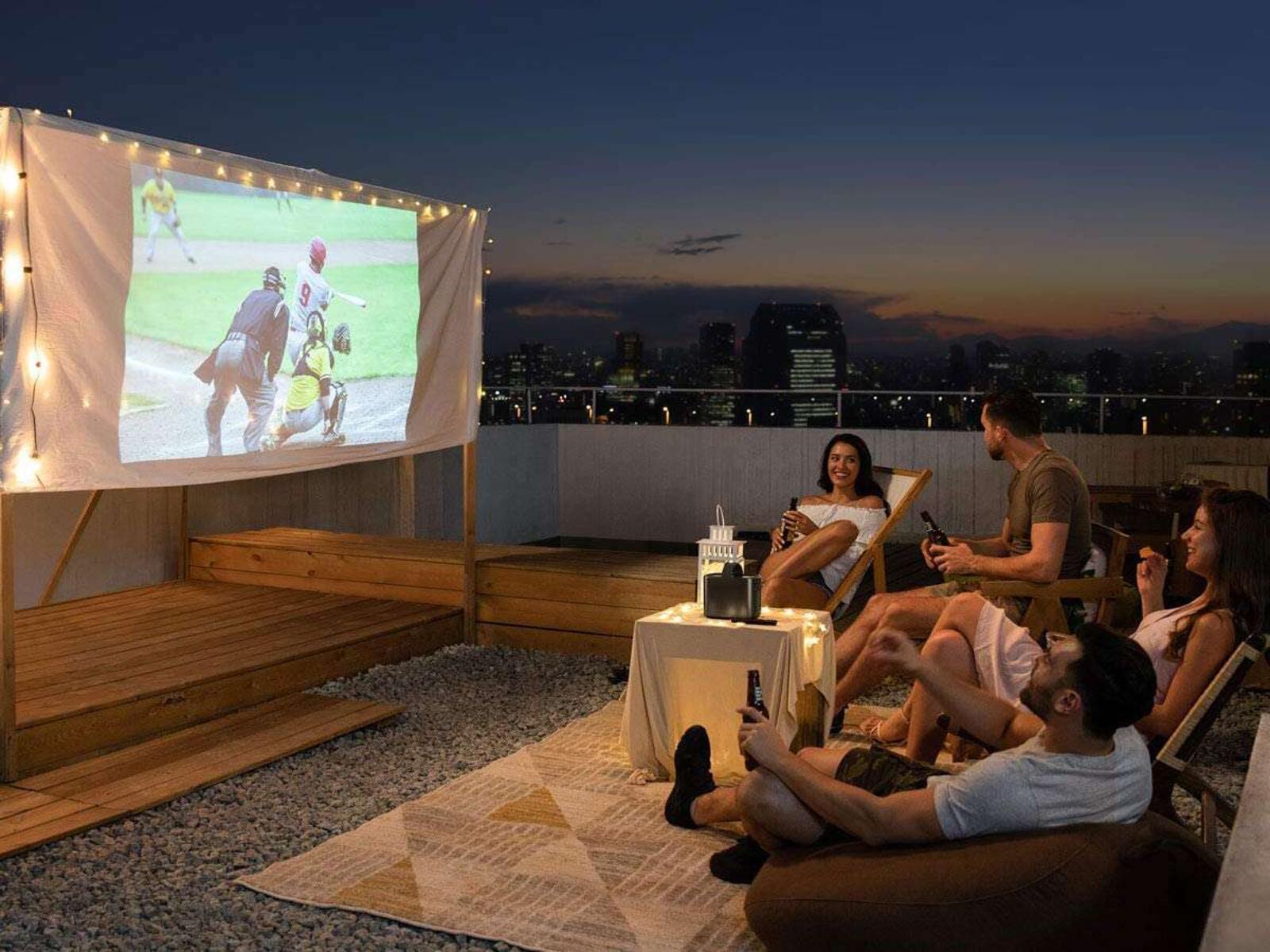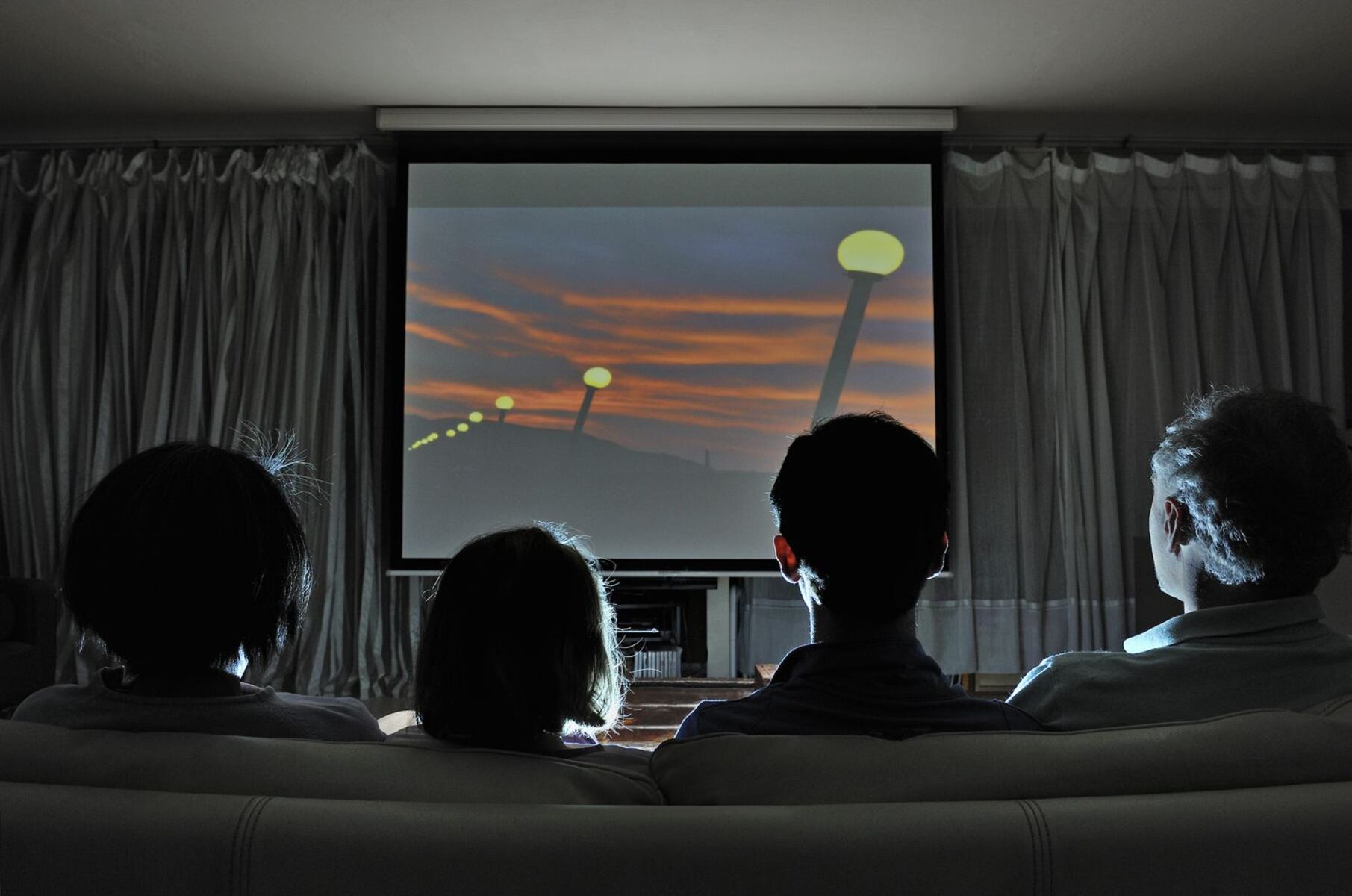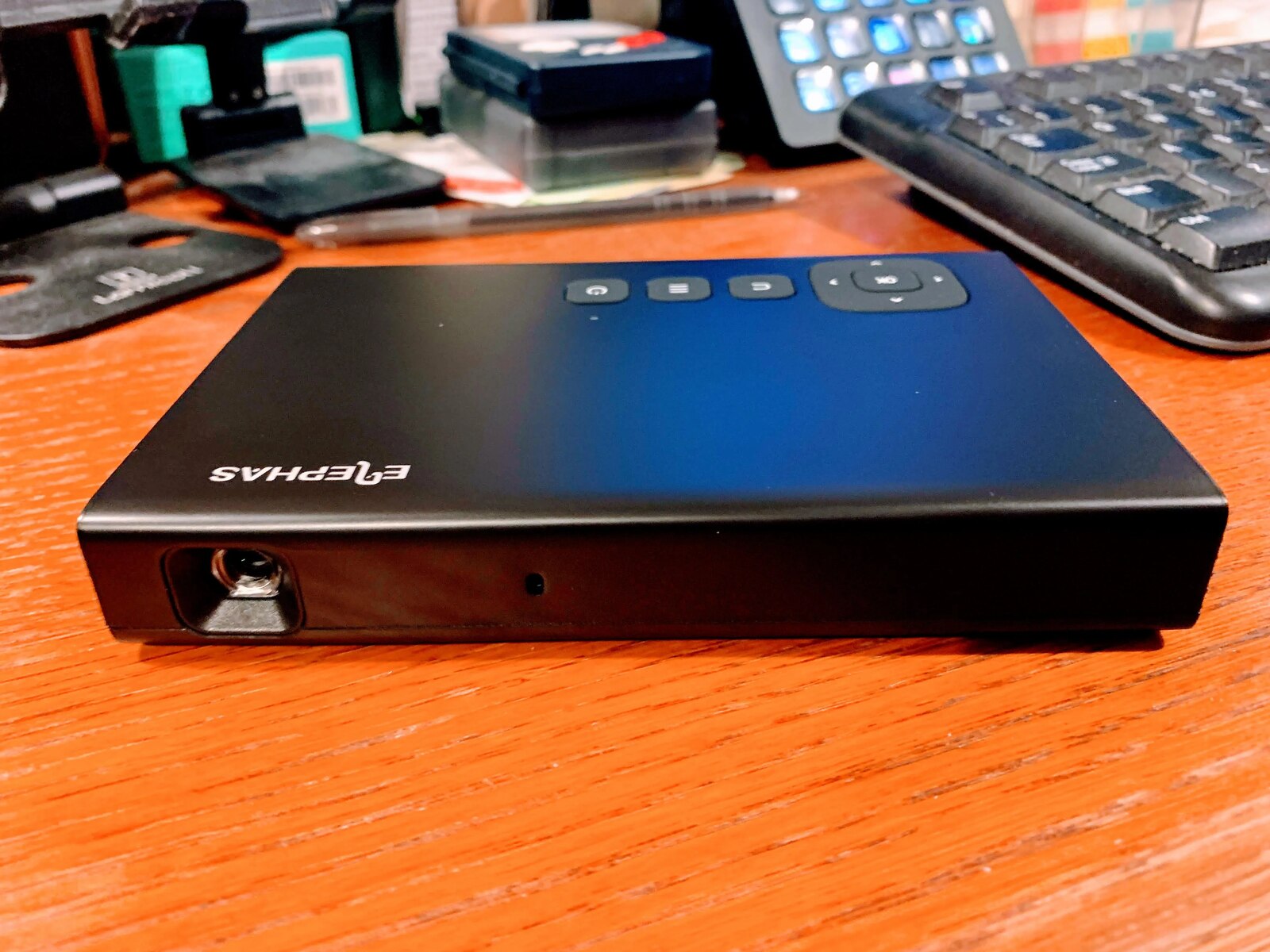Introduction
When it comes to choosing between a projector and a TV, the decision is not always easy. Both options offer unique advantages and drawbacks that need to be carefully considered. Whether you are setting up a home theater, upgrading your entertainment system, or looking for a versatile display for your business, understanding the characteristics of projectors and TVs is crucial.
Projectors have long been favored for their ability to create larger-than-life images, providing a truly immersive viewing experience akin to a movie theater. On the other hand, TVs offer convenience, sleek designs, and advanced features that can enhance your viewing pleasure.
Size and Viewing Experience:
One of the primary factors to consider when choosing between a projector and a TV is the desired screen size. Projectors are known for their ability to project images onto large surfaces, allowing for an expansive and impressive viewing experience. With a projector, you can transform your living room or dedicated theater room into a cinematic haven, immersing yourself in your favorite movies, shows, and games.
On the other hand, TVs come in a range of sizes, from compact units suitable for small spaces to large-scale displays that can be the centerpiece of any room. Whether you prefer a cozy setup or a grand visual experience, TVs offer flexibility in choosing the desired screen size.
Image Quality:
When it comes to image quality, both projectors and TVs have come a long way in recent years. However, there are some differences to consider. Projectors use light sources and lenses to project images onto a screen or surface, which can result in a softer image compared to TVs. TVs, on the other hand, use pixel-based displays with backlighting, providing sharper and more vibrant images.
Resolution and Pixel Density:
Resolution plays a crucial role in determining image quality. TVs typically offer higher resolutions, such as 4K or even 8K, resulting in crisper details and more lifelike visuals. Projectors generally have lower native resolutions, but they can still deliver impressive image quality, especially when combined with advanced upscaling technology.
Contrast Ratio:
Contrast ratio refers to the difference between the brightest and darkest parts of an image. TVs tend to have higher contrast ratios, allowing for more defined shadows, depth, and details. Projectors, although they may have lower contrast ratios, can still produce decent results, especially when used in a controlled lighting environment.
Color Accuracy and Gamut:
Color accuracy and gamut determine how accurately a display can reproduce colors. TVs have advanced color processing capabilities, incorporating technologies like High Dynamic Range (HDR) and Wide Color Gamut (WCG) to deliver stunning and true-to-life colors. Projectors, while not reaching the same levels of color accuracy as TVs, can still provide vivid and enjoyable color reproduction.
Viewing Angle:
Viewing angle refers to the maximum angle from which you can still view the display without experiencing a loss in image quality. TVs typically offer wider viewing angles, ensuring that everyone in the room can enjoy a clear and detailed picture. Projectors, however, may have more limited viewing angles, requiring careful placement to optimize the viewing experience.
Connectivity:
Both projectors and TVs offer a range of connectivity options, including HDMI, USB, and audio ports, allowing you to connect various devices such as gaming consoles, streaming devices, and sound systems. TVs often have more built-in features and connectivity options, such as Wi-Fi and Bluetooth, making it easier to access online content and connect to other devices wirelessly. Projectors may require additional accessories or devices to provide the same level of connectivity.
This is just the beginning of our exploration into the projector vs. TV debate. In the following sections, we will delve deeper into the factors to consider when making your decision, including durability, portability, sound quality, price range, energy consumption, and maintenance requirements. So, buckle up and get ready to discover which option suits your needs best!
Size and Viewing Experience
When it comes to creating a truly immersive viewing experience, both the size and the visual impact play crucial roles. This is where the difference between projectors and TVs becomes apparent. Projectors are well-known for their ability to transform any space into a theater-like setting, allowing you to enjoy your favorite movies, sports events, or gaming sessions on an expansive screen.
With a projector, you have the freedom to choose the screen size that suits your preferences and space. Whether you want a modest 80-inch display or a jaw-dropping 150-inch behemoth, projectors can accommodate your needs. Such large screen sizes enhance the sense of immersion, making you feel like you’re right in the middle of the action.
On the other hand, while TVs may not offer the same scale as projectors, they provide their own advantages when it comes to size. TVs come in a variety of sizes, ranging from compact units suitable for small rooms to massive displays that become the focal point of any entertainment space. This versatility allows you to find the perfect fit for your room, ensuring an optimal viewing experience.
Additionally, TVs can be mounted on walls or placed on stands, giving you more flexibility in terms of positioning and placement. This comes in handy, especially in rooms with limited wall space or unconventional layouts.
When deciding between a projector and a TV, it’s important to consider the size of your space and your personal viewing preferences. If you have a room dedicated solely to entertainment and want a truly immersive experience, a projector may be the way to go. However, if you have a smaller room or prefer a more compact setup, a TV can provide an excellent viewing experience without the need for extensive installation or additional equipment.
Ultimately, the choice between a projector and a TV in terms of size and viewing experience boils down to personal preference and the available space. Consider the layout of your room, the desired screen size, and how you envision your entertainment setup to make an informed decision.
Image Quality
When it comes to the visual experience, image quality is of utmost importance. Both projectors and TVs have made significant advancements in this area, providing stunning visuals that can elevate your viewing pleasure.
Projectors use a combination of light sources and lenses to project images onto a screen or surface. While projectors may not offer the same level of pixel density as TVs, they can still produce impressive image quality, especially when used in the right environment. The larger the screen size, the more important it becomes to have a projector that can maintain sharpness and clarity. High-quality projectors utilize advanced image processing technologies and lens systems to deliver detailed and vibrant visuals.
On the other hand, TVs rely on pixel-based displays with backlighting to create images. This allows TVs to offer higher pixel density and sharper details compared to projectors. With technologies like 4K and 8K resolutions, TVs can provide incredibly crisp visuals with lifelike precision. The pixel density of TVs ensures that even smaller details are displayed with utmost clarity, making it ideal for enjoying high-definition content.
Another aspect to consider is the contrast ratio, which refers to the difference between the brightest and darkest parts of an image. TVs generally have higher contrast ratios, resulting in more defined shadows, depth, and details. This creates a more immersive and realistic visual experience, especially when viewing content with dark or light scenes. Projectors, although they may have lower contrast ratios compared to TVs, can still produce decent results, especially when used in a controlled lighting environment.
Color accuracy and gamut are also essential factors that contribute to image quality. TVs often incorporate technologies such as High Dynamic Range (HDR) and Wide Color Gamut (WCG) to provide a wide range of colors and accurate color reproduction. This results in stunning visuals with vibrant and realistic color representation. While projectors may not have the same level of color accuracy as TVs, they can still provide enjoyable and vivid color reproduction, enhancing your viewing experience.
When deciding between a projector and a TV, it is crucial to consider the desired image quality and the types of content you will be consuming. If you prioritize larger screen sizes and immersive experiences, projectors can deliver impressive visuals. However, if you seek the highest pixel density and sharper details, TVs with their advanced display technologies may be the better choice.
Ultimately, the choice between a projector and a TV in terms of image quality depends on your personal preferences, the viewing environment, and the type of content you plan to enjoy.
Resolution and Pixel Density
Resolution and pixel density are crucial factors to consider when comparing projectors and TVs, as they directly impact the clarity and level of detail in the displayed images.
TVs typically offer higher resolutions compared to projectors. The most common resolutions for TVs are Full HD (1920 x 1080 pixels), 4K Ultra HD (3840 x 2160 pixels), and even 8K (7680 x 4320 pixels) in some high-end models. These higher resolutions result in sharper and more detailed visuals, allowing you to see every minute detail in the content you are viewing.
Projectors, on the other hand, generally have lower native resolutions compared to TVs. Common resolutions for projectors include HD (1280 x 720 pixels) or Full HD (1920 x 1080 pixels). However, it’s worth noting that projectors can still provide impressive image quality, especially when combined with advanced upscaling technology.
Upscaling refers to the process of enhancing lower-resolution content to fit higher-resolution displays. Many projectors now incorporate upscaling algorithms that can analyze and interpolate the pixels to make the image appear sharper on the screen. While upscaling can improve the image quality, it may not match the native resolution and pixel density of a TV.
The pixel density of a display also plays a significant role in determining the level of detail. Pixel density refers to the number of pixels packed into a given physical space on the screen. TVs typically have higher pixel densities, resulting in sharper images. This is particularly noticeable when viewing content with fine details, such as text or intricate patterns.
However, it’s important to consider the viewing distance when evaluating the impact of resolution and pixel density. When you sit farther away from the screen, the differences in pixel density become less noticeable. In a home theater setup with a projector, for example, the larger screen size allows viewers to sit at a comfortable distance while still enjoying a visually appealing experience.
Ultimately, the choice between a projector and a TV in terms of resolution and pixel density depends on your priorities and viewing habits. If you value the highest resolution and pixel density for sharp and detailed visuals, a TV with its higher native resolution may be the better option. However, if you prioritize a larger screen size and a more immersive experience, projectors can still offer impressive image quality, especially when equipped with upscaling technology.
Consider the size of the room, the distance from the screen, and your personal preferences to make an informed decision on whether resolution and pixel density are major determining factors for your setup.
Contrast Ratio
When discussing image quality, one important aspect to consider is the contrast ratio. Contrast ratio refers to the difference between the brightest and darkest parts of an image, which affects the depth, detail, and overall visual impact.
TVs typically excel in this area, offering higher contrast ratios compared to projectors. The backlighting technology used in most TVs allows for precise control of brightness levels, resulting in more defined shadows, deeper blacks, and enhanced details in darker scenes. This creates a more immersive and visually engaging experience when watching movies, shows, or playing games with varying lighting conditions.
On the other hand, projectors may have lower contrast ratios compared to TVs. The ambient light in the room can impact the perceived contrast, as projectors rely on projecting light onto a screen or surface. However, advancements in projector technology have resulted in improved contrast ratios, providing better differentiation between light and dark areas of the image.
It’s important to note that the contrast ratio can vary depending on the environmental conditions in which the projector is used. In a room with complete light control, such as a dedicated home theater, projectors can achieve impressive contrast ratios. However, in a room with ambient light or bright lighting, the perceived contrast ratio may be lower due to the light interference.
When comparing the contrast ratios of projectors and TVs, it’s crucial to take into account the specific needs of your viewing environment. If you have a controlled lighting environment or plan to use the projector in dimly lit conditions, the contrast ratio may be less of a concern. However, if you have a brightly lit room or want to achieve the deepest blacks and highest contrast in your visuals, a TV with its advanced backlighting features may be the better choice.
Ultimately, the contrast ratio is just one aspect to consider when deciding between a projector and a TV. It’s important to evaluate other factors such as the viewing environment, the content you enjoy, and your personal preferences to determine the best option for your specific needs.
Color Accuracy and Gamut
Color accuracy and gamut are essential factors to consider when comparing the color reproduction capabilities of projectors and TVs. The ability to accurately reproduce colors can significantly impact your viewing experience, especially when it comes to enjoying movies, TV shows, and other visually stunning content.
TVs often incorporate advanced color processing technologies and features like High Dynamic Range (HDR) and Wide Color Gamut (WCG) to deliver vibrant and true-to-life colors. HDR expands the range of brightness levels and contrast, resulting in more dynamic visuals with rich colors and detailed shadows. WCG, on the other hand, allows for a wider range of colors to be displayed, making the on-screen visuals more vivid and captivating.
With these features, TVs can accurately display a wide range of colors, ensuring that the content you view appears as intended by the creators. Whether it’s the lush greens of a forest, the deep blues of the ocean, or the fiery reds of a sunset, TVs can reproduce these colors with precision and depth.
While projectors may not reach the same level of color accuracy as TVs, they can still provide enjoyable and vibrant color reproduction. Projectors use a combination of light sources and optical systems to create images, and advancements in technology have improved their color capabilities. Many projectors now come equipped with color management systems and color profiles that allow for adjustments and customization, ensuring that the colors on the screen are as accurate as possible.
When it comes to color gamut, TVs generally have a wider range compared to projectors. This means that TVs can reproduce a larger percentage of the visible color spectrum, resulting in more accurate and vivid colors. However, projectors have made significant strides in this area, and some high-end models can now achieve respectable color gamuts that come closer to what TVs offer.
It’s important to note that the perceived color accuracy and gamut can also be influenced by external factors such as ambient lighting conditions. Both projectors and TVs may exhibit variations in color reproduction depending on the brightness, color temperature, and type of lighting in the room.
When considering color accuracy and gamut, it’s crucial to assess your specific needs and viewing environment. If accurate and vibrant color reproduction is a high priority for you, a TV with its advanced color processing technologies may be the better choice. However, if you can control the lighting conditions in your viewing area and are willing to invest in a high-quality projector, you can still enjoy engaging and visually captivating colors.
Ultimately, the choice between a projector and a TV in terms of color accuracy and gamut depends on your personal preferences, the level of color fidelity you desire, and the way you plan to use the display in your specific viewing environment.
Viewing Angle
Viewing angle refers to the maximum angle from which you can still view the display without experiencing a loss in image quality. It is an important consideration, particularly in situations where multiple people will be watching the screen simultaneously or if you have a large viewing area.
When it comes to viewing angles, TVs generally have an advantage over projectors. TVs are designed with technologies like In-Plane Switching (IPS) or Vertical Alignment (VA) panels that offer wider viewing angles. This means that viewers can enjoy a clear and detailed picture even when sitting off to the sides of the screen. The larger the viewing angle, the more flexibility you have in terms of seating arrangements and positioning in the room.
On the other hand, projectors may have more limited viewing angles. Since the image is projected onto a screen or surface, the optimal viewing position is usually directly in front of the screen. Deviating too much from the center can result in a loss of image quality, such as reduced brightness or color accuracy. Therefore, when setting up a projector, it is important to consider seating arrangements and ensure that everyone in the room has a good view without sacrificing image quality.
However, it’s worth noting that with proper placement and adjustments, projectors can still provide an enjoyable viewing experience for a wider audience. Tilted screens or projector mounts that allow for angle adjustments can help optimize the viewing angle and accommodate a larger number of viewers. Additionally, some projectors offer features like lens shift and keystone correction that allow for further fine-tuning of the image and viewing angle.
When considering the viewing angle, it is important to take into account the size of the room, the seating arrangement, and the number of people who will be watching. If you have a large space or frequently host gatherings, a TV with its wider viewing angles may be more suitable to ensure that everyone can enjoy an optimal visual experience from any position in the room. However, if you have a dedicated seating area or can position the projector for optimal viewing, projectors can still provide an immersive and engaging viewing experience.
Ultimately, the choice between a projector and a TV in terms of viewing angle depends on your specific needs and the viewing dynamics in your space. Assessing the room layout and seating arrangements can help determine which option provides the best viewing experience for you and your audience.
Connectivity
When it comes to connectivity, both projectors and TVs offer a range of options to connect various devices and enhance your overall viewing experience. Whether it’s gaming consoles, streaming devices, sound systems, or other peripherals, having the right connectivity options is crucial for accessing and enjoying your desired content.
TVs generally come equipped with a wide array of built-in connectivity options. This often includes multiple HDMI ports, USB ports, component inputs, and audio outputs. These connections allow you to connect gaming consoles, Blu-ray players, streaming devices, and other external devices directly to your TV. This easy access to a variety of ports ensures a seamless and convenient setup, especially if you have multiple devices that you frequently switch between.
Additionally, many modern TVs have integrated Wi-Fi capabilities, enabling you to connect to the internet and access online streaming services, apps, and other digital content. This wireless connectivity eliminates the need for additional cables and enables you to stream your favorite movies, TV shows, and music directly on your TV.
Projectors also offer connectivity options to meet your needs. HDMI ports are a common feature for most projectors, allowing you to connect devices like gaming consoles, laptops, and DVD/Blu-ray players. Some projectors also provide VGA ports for connecting older devices, and USB ports for playing media files directly from a USB drive.
However, projectors may have fewer built-in features compared to TVs. To access online content or streaming services, additional devices such as a streaming stick or media player may be required. These devices can be connected to the projector’s HDMI port to bring internet connectivity and access to a wide range of digital content.
It’s important to consider the specific devices and sources you plan to connect to your display when assessing connectivity options. If you have multiple devices and want a straightforward setup, a TV with its built-in ports and wireless capabilities may be the better choice. However, if you require flexibility in connecting various devices and are willing to invest in additional accessories, projectors can offer a versatile and customizable solution.
When comparing the connectivity options of projectors and TVs, it’s also crucial to consider the audio output. Both projectors and TVs generally come with built-in speakers. However, for a more immersive and high-quality audio experience, additional sound systems or speakers may be necessary. Both projectors and TVs often support external audio connections, such as optical audio outputs or audio line outputs, allowing you to connect to a surround sound system or external speakers for enhanced audio performance.
In summary, connectivity is an important aspect to consider when choosing between a projector and a TV. TVs typically offer more built-in ports and wireless connectivity options, providing an all-in-one solution. Projectors may require additional devices and accessories for certain connectivity features, but they can offer more flexibility and customization based on your specific needs and devices.
Durability and Lifespan
When investing in a projector or a TV, it’s important to consider the durability and lifespan of the device. Understanding the longevity and reliability of your chosen display can help you make a more informed decision and ensure that your investment will last for years to come.
TVs are generally designed to be durable and long-lasting. They are built with sturdy materials and undergo rigorous testing to ensure that they can withstand everyday use. The components within a TV, such as the display panel, electronics, and internal components, are specifically designed to offer a reliable and consistent performance over an extended period. This ensures that your TV can deliver high-quality visuals and functionality for years without significant issues.
Additionally, TVs typically come with manufacturer warranties, ranging from one to several years, providing added peace of mind. These warranties cover various components and offer potential replacements or repairs in case of defects or malfunctions. It’s important to check the warranty terms and conditions when purchasing a TV, as they can vary depending on the brand and model.
Projectors, like TVs, also strive for durability, but they may have different considerations due to their design and usage. Projectors are often portable and meant to be moved around, so they need to be constructed with durability in mind. The outer casing of projectors is typically made from robust materials that can withstand transportation and various environments.
However, it’s worth noting that projectors contain delicate and precise optical components, such as lenses and mirrors, which require careful handling and maintenance to ensure long-term performance. You may need to clean the lens periodically and ensure that the projector is stored in a safe and dust-free environment when not in use.
The lifespan of a projector bulb is an important factor to consider as well. Projectors utilize bulbs or lamps to generate the light that creates the projected image. These bulbs have a limited lifespan and will eventually require replacement. The lifespan of a projector bulb can vary depending on factors such as usage time, brightness settings, and the quality of the bulb itself. Regular use and prolonged operating hours can lead to a shorter lifespan, requiring a replacement bulb sooner.
When comparing the durability and lifespan of projectors and TVs, it’s important to understand the intended usage and the care required for each device. TVs generally offer a longer lifespan and require minimal maintenance, making them a reliable option for long-term use. Projectors, while they may have more delicate components and require periodic bulb replacements, can still provide durability and longevity when properly maintained.
In summary, both projectors and TVs can offer durability and a long lifespan, but the longevity and maintenance requirements may differ. TVs are built to withstand everyday use and often come with warranties for added protection. Projectors require careful handling and regular bulb replacements, but they can still provide reliable performance over time. Consider your usage patterns, maintenance capabilities, and desired longevity when making a decision.
Portability and Flexibility
When it comes to portability and flexibility, projectors have a clear advantage over TVs. Projectors are designed to be compact and lightweight, making them highly portable and easy to move from one location to another. This portability allows you to enjoy your favorite movies, shows, or presentations in different rooms or even outdoors.
Whether you’re setting up a backyard movie night or need a display for a business presentation, projectors offer the flexibility to adapt to various environments. They can be easily mounted on a ceiling, placed on a stand, or even temporarily positioned on a table. This gives you the freedom to create a viewing experience anywhere you desire.
Projectors also offer flexibility in terms of screen size. With a projector, you can adjust the projected image to fit the available space, giving you the ability to customize the viewing experience according to your preferences. This makes projectors suitable for both small and large rooms, allowing you to create an immersive home theater experience or set up a presentation in a spacious conference room.
On the other hand, TVs are generally less flexible in terms of portability due to their larger and heavier nature. Moving a TV from one location to another can be a more cumbersome task, especially if it requires dismantling and reinstallation. TVs are typically positioned in a fixed location, such as mounted on a wall or placed on a TV stand, restricting their adaptability to different rooms or settings.
While projectors offer greater portability and flexibility, it’s important to consider the setup requirements. Projectors need to be positioned correctly and generally require a flat surface or screen to project onto. Additionally, ambient lighting conditions can impact the quality of the projected image, so they work best in settings where lighting can be controlled.
When determining whether portability and flexibility are important factors for you, consider your specific needs and how you plan to use the display. If you require the ability to easily move the display or use it in different locations, a projector provides the versatility and convenience you’re looking for. However, if you prefer a fixed location or don’t have a need for mobility, a TV can offer a reliable and stationary viewing experience.
In summary, projectors provide greater portability and flexibility compared to TVs. They are lightweight, easy to transport, and can be set up in various locations. TVs, while less portable, are typically fixed in one location, offering stability and a permanent visual solution. Consider your specific requirements and the level of adaptability you need to make an informed decision.
Sound Quality and Audio Options
When it comes to enjoying an immersive viewing experience, sound plays a crucial role alongside the visual elements. Both projectors and TVs offer various sound options, but there are differences to consider when evaluating their sound quality and audio capabilities.
TVs typically come with built-in speakers that are specifically designed to provide decent sound quality. Many modern TVs have advanced audio technologies like Dolby Digital or DTS, offering a more immersive and cinematic audio experience. These built-in speakers can often deliver clear dialogue, balanced mid-range, and respectable volume levels. However, the sound quality can vary depending on the TV model and its built-in speaker system.
For those seeking a more immersive and high-quality audio experience, external audio options are available for both projectors and TVs. Both devices typically offer audio output ports such as optical audio or HDMI ARC (Audio Return Channel), which allow you to connect external sound systems or speakers for enhanced audio performance. With a dedicated sound system or surround sound setup, you can enjoy a more immersive and theater-like audio experience, truly complementing the visuals on the screen.
Projectors, especially portable ones, may have relatively smaller built-in speakers due to their compact size. While these speakers can provide basic audio output, they may not deliver the same level of sound quality and immersion as dedicated sound systems or larger TVs. However, projectors often offer more flexibility in terms of audio connectivity options. Like TVs, projectors often have audio output ports to connect to external sound systems or speakers, allowing you to optimize the audio experience based on your preferences.
When deciding which option suits your audio needs, it’s important to consider the size and layout of your viewing space, as well as your audio preferences. If you prioritize sound quality and a more immersive audio experience, a TV with a built-in speaker system or an external sound system can provide a robust audio solution. However, if you prefer flexibility and the ability to connect to external sound systems or speakers, projectors may be the better choice.
It’s worth noting that when connecting external audio devices, both projectors and TVs should support the necessary audio formats and connectivity options. Check the specifications and audio compatibility of the device you are considering to ensure that it aligns with your audio setup requirements.
In summary, while TVs typically offer more robust built-in speakers, both projectors and TVs provide options to enhance the audio experience. TVs may offer better sound quality out of the box, while projectors provide flexibility in connecting to external audio systems. Determine your audio expectations and the desired level of immersion to make an informed decision on which device suits your audio needs.
Price Range and Affordability
When comparing projectors and TVs, another crucial factor to consider is the price range and affordability of each option. The cost of the device plays a significant role in the decision-making process, as it determines how much you are willing to invest in your viewing experience.
TVs come in a wide range of price points, offering options for various budgets. The cost of a TV depends on several factors, including the brand, screen size, display technology, resolution, and additional features. Generally, larger and higher-resolution TVs tend to be more expensive, especially if they incorporate advanced technologies like OLED or QLED for enhanced color reproduction and contrast ratios.
However, it’s important to note that in recent years, the prices of TVs have become more affordable, with many manufacturers offering competitive options in the market. This means that even for those with a limited budget, there are TVs available that deliver respectable image quality and features without breaking the bank.
On the other hand, projectors can also vary in price depending on their features and capabilities. Entry-level projectors are often more affordable and can provide a basic viewing experience. However, high-end projectors with advanced features, higher resolutions, and better image quality can be significantly more expensive.
It’s essential to consider the additional costs that may be associated with projectors, such as projector screens, ceiling mounts, and replacement bulbs. These factors should be taken into account when comparing the overall cost of a projector setup to that of a TV.
When considering price range and affordability, it’s important to identify your specific requirements and budget constraints. If you are looking for a more cost-effective option and have specific size constraints or a limited budget, a TV may be the better choice. TVs offer a wide range of options at different price points, allowing you to find a display that fits your budget without sacrificing too much in terms of image quality and features.
On the other hand, if you have a larger space, desire a more immersive experience, or simply prefer the flexibility of a projector, it’s important to allocate a budget that can accommodate the cost of a high-quality projector and its necessary accessories.
Ultimately, it’s a balancing act between desired features, budget considerations, and personal preferences when choosing between projectors and TVs based on price range and affordability. Consider your priorities and the amount you are willing to spend to make an informed decision on the best option for your needs.
Energy Consumption and Eco-friendly Features
In today’s world, energy efficiency and eco-friendly features are becoming increasingly important considerations when choosing electronic devices. Both projectors and TVs have made strides in reducing energy consumption and incorporating eco-friendly features to help minimize their environmental impact.
TVs are typically designed to be energy efficient, with many models now carrying energy efficiency certifications like Energy Star. These certifications ensure that the TV meets strict energy-saving standards, reducing power consumption during operation. Additionally, many TVs come equipped with features like automatic power-off or standby modes, which help conserve energy when the device is not in use for extended periods.
LED TVs in particular are known for their energy efficiency. LED backlighting technology consumes less energy compared to older CCFL (Cold Cathode Fluorescent Lamp) backlights, resulting in a more environmentally friendly and cost-effective solution. OLED TVs take energy efficiency a step further by eliminating the need for backlighting altogether, as they are capable of individually controlling each pixel’s brightness.
Projectors have also made advancements in energy efficiency. Many projectors now feature energy-saving modes that automatically adjust brightness levels and power consumption based on content and ambient lighting conditions. This helps reduce energy consumption without sacrificing image quality. Some projectors also offer eco-mode options, which further optimize power usage.
When evaluating the eco-friendliness of projectors and TVs, it’s important to consider factors beyond energy consumption. Consider the materials used in the manufacturing process and the impact they have on the environment. Look for devices that are made from environmentally friendly materials and that adhere to eco-friendly manufacturing practices.
Additionally, consider the device’s recyclability and disposal options. Projectors and TVs should be properly recycled or disposed of at the end of their lifespan to minimize their impact on the environment. Look for environmental certifications or manufacturer programs that promote responsible recycling or take-back initiatives for electronic devices.
When deciding between a projector and a TV based on energy consumption and eco-friendly features, consider your own values and priorities. If energy efficiency and eco-friendliness are important to you, look for devices with energy-saving certifications, eco-friendly manufacturing practices, and responsible disposal options. LED TVs and projectors with energy-saving modes can also be good options for reducing overall power consumption.
It’s important to note that while both projectors and TVs have made efforts to improve energy efficiency and incorporate eco-friendly features, the level of sustainability may vary between models and brands. As a conscious consumer, it’s advisable to research and compare different options to make an informed decision that aligns with your eco-friendly goals.
Maintenance and Upkeep
Maintenance and upkeep are important factors to consider when choosing between a projector and a TV. Understanding the maintenance requirements of each device can help you maintain optimal performance and prolong the lifespan of your chosen display.
TVs generally require minimal maintenance. Once properly installed and connected, TVs typically do not require regular adjustments or maintenance tasks. However, it’s important to keep the TV screen clean by dusting it regularly using a soft, microfiber cloth. Avoid using harsh chemicals or abrasive materials that could damage the screen. Some TVs also offer built-in self-diagnostic features to detect and troubleshoot any potential issues.
Projectors, on the other hand, require more frequent maintenance to ensure optimal performance. One crucial aspect of projector maintenance is cleaning the lens. Dust, fingerprints, or smudges on the lens can affect image quality and clarity. Cleaning the lens periodically with a lens cloth or compressed air can help maintain sharp and vibrant visuals.
Another maintenance requirement for projectors is replacing the bulb or lamp. Projector bulbs have a limited lifespan and can eventually burn out. The lifespan of a bulb can vary depending on usage hours, brightness settings, and the quality of the bulb itself. When the bulb reaches the end of its life, it needs to be replaced to maintain the projector’s functionality. It’s important to consult the projector’s manual or manufacturer guidelines for specific instructions on replacing the bulb.
Projectors may also require adjustments or calibration to maintain optimal image quality. This can involve adjusting the projection focus, keystone correction, or color settings. Some projectors offer automated calibration features that make this process easier. Regularly checking and adjusting these settings as needed can help ensure that the projected image remains sharp, vibrant, and free from distortions.
When maintaining projectors, it’s also important to consider the cleanliness and ventilation of the projector itself. Dust accumulation can affect the cooling system and may lead to overheating. Regularly checking for dust build-up and cleaning the projector’s vents can help prevent potential issues and ensure efficient cooling.
It’s important to note that the maintenance requirements can vary between different projector models and brands. Some projectors may have filters that need periodic cleaning or replacement, while others may offer additional features or maintenance tasks. It’s advisable to consult the user manual or manufacturer guidelines for specific maintenance instructions and recommendations.
When considering maintenance and upkeep, it’s necessary to evaluate your own comfort level and willingness to perform regular maintenance tasks. If you prefer a low-maintenance option, a TV may be the better choice. However, if you are willing to invest the time and effort in maintaining and optimizing the performance of a projector, it can provide a rewarding and customizable viewing experience.
In summary, projectors generally require more maintenance and upkeep compared to TVs. TVs have minimal maintenance requirements and often only require cleaning the screen. Projectors, on the other hand, may require cleaning the lens, replacing bulbs, adjusting image settings, and ensuring proper cooling. Consider your willingness and ability to perform regular maintenance tasks when deciding between a projector and a TV.
Conclusion
Choosing between a projector and a TV ultimately comes down to personal preference, specific requirements, and the specific characteristics that matter most to you. Both projectors and TVs offer unique advantages, and understanding the key factors discussed throughout this article can help you make an informed decision.
Projectors excel in creating an immersive viewing experience with larger screen sizes, making them ideal for home theaters or situations where a cinematic feel is desired. They offer portability, flexibility, and the ability to transform any space into a captivating entertainment hub. Projectors also provide versatility in terms of screen size and placement options, allowing you to customize your viewing experience according to your preferences.
On the other hand, TVs offer convenience, sleek designs, and a wide range of sizes to fit various spaces. They come with advanced features, high resolutions, and vibrant image quality. TVs often have better sound quality, built-in connectivity options, and require minimal maintenance. They are well-suited for rooms with controlled lighting conditions or those that prioritize a fixed, reliable viewing experience.
Consider the size of your space, desired screen size, image quality preferences, viewing distance, and budget when making a decision. Think about whether you value portability and flexibility, or if you prefer the ease of installation and comprehensive features that come with a TV. Take into account your room setup, lighting conditions, desired audio experience, and whether eco-friendliness and energy efficiency are important factors for you.
Remember that both projectors and TVs have made significant advancements, and the specific models and brands you choose can greatly impact your overall experience. Research and compare different options, read reviews from other users, and consider seeking professional advice to find the best fit for your needs.
Ultimately, the choice between a projector and a TV is a highly personal one. Whether you opt for the immersive experience of a projector or the convenient and feature-rich nature of a TV, prioritize the factors that matter most to you and create the perfect setup for your entertainment needs.







